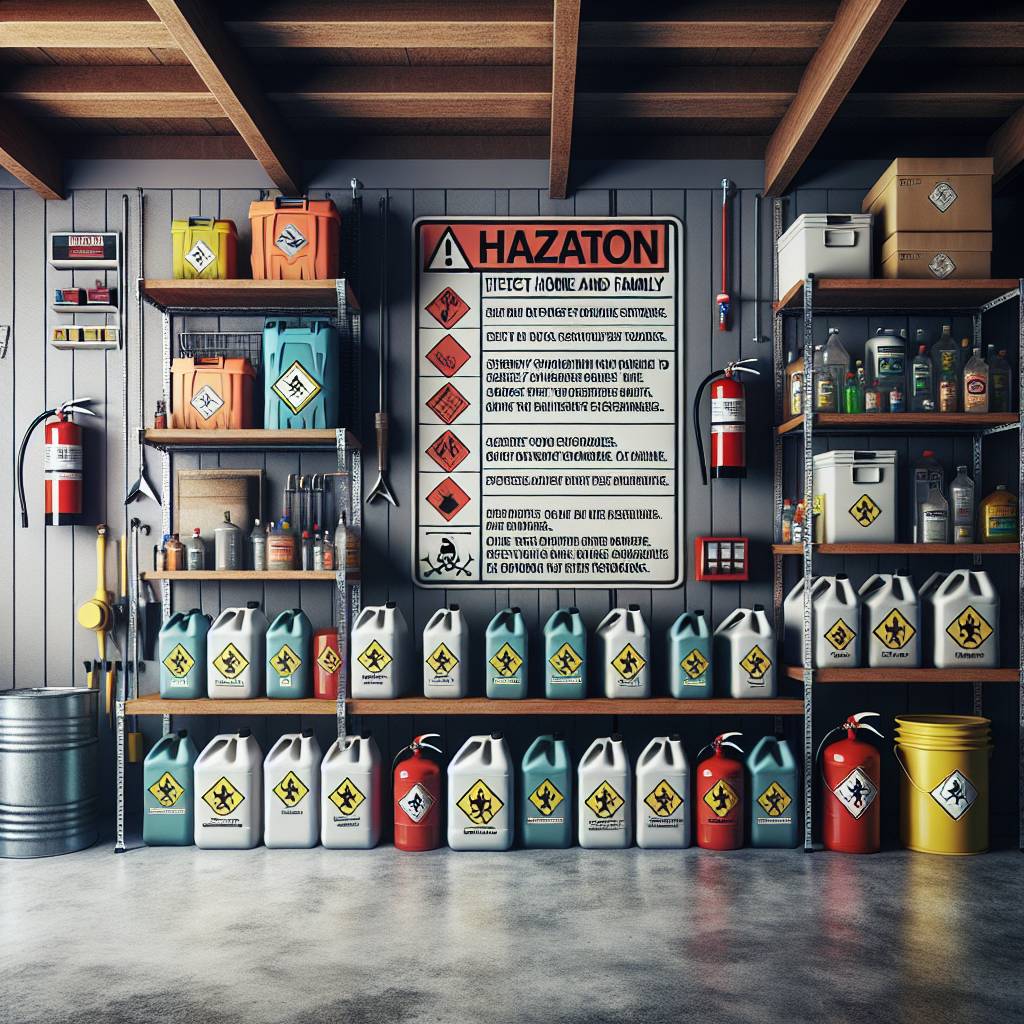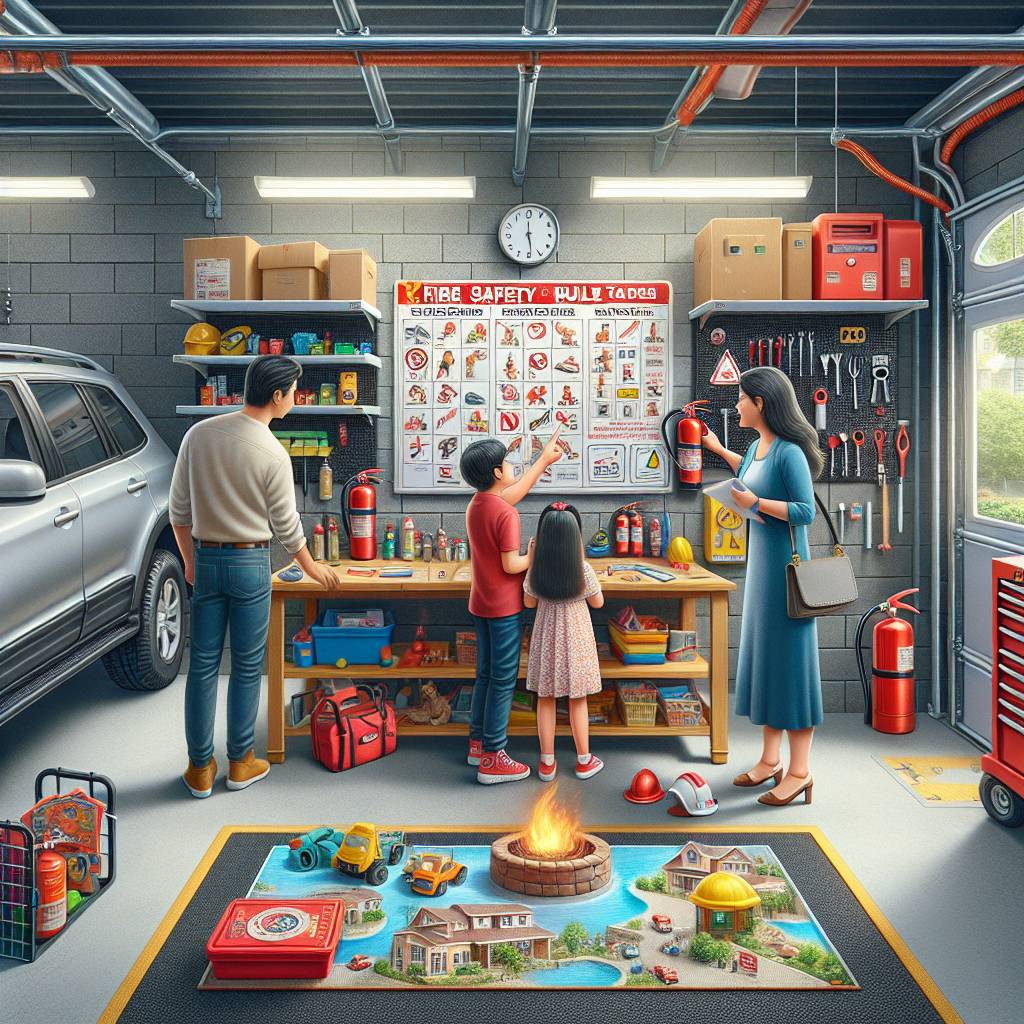Garages often serve as storage spaces for various items, including potentially hazardous substances. From motor oil to pesticides, these toxic materials can pose serious health and safety risks if not handled or stored properly. We’ll delve into practical advice on proper labeling, secure storage solutions, and the importance of ventilation to minimize exposure to harmful fumes. We’ll discuss the potential environmental impact of improper disposal practices and offer eco-friendly alternatives.
Key Takeaways
- Properly store hazardous materials in your garage to minimize the risk of accidents and exposure.
- Implement safety measures in your workshop to protect yourself and others from potential harm.
- Take steps to safeguard children and pets from accessing toxic substances in the garage.
- Familiarize yourself with emergency handling procedures for hazardous materials to respond effectively in case of spills or accidents.
- Be mindful of the storage and handling of chemicals, cleaners, fertilizers, and garden chemicals to prevent contamination and accidents.
- Ensure the security of your garage door to prevent unauthorized access to hazardous materials.
Overview of Hazardous Materials
Common Types
Toxic substances commonly found in garages include pesticides, herbicides, paints, solvents, and fertilizers. These substances often contain harmful chemicals such as lead, mercury, and volatile organic compounds (VOCs). Pesticides, for example, are designed to kill pests but can also pose health risks to humans if not handled properly. Similarly, paints and solvents may emit fumes that can be hazardous when inhaled.
Understanding the characteristics of these toxic substances is crucial for ensuring safety in the garage. For instance, recognizing that certain products are flammable or reactive with other chemicals helps prevent accidents. It’s important to know how different toxic substances behave under various conditions to mitigate potential dangers effectively. By being aware of their properties, individuals can take appropriate precautions when handling or storing these materials.
Importance of Storage
Proper storage of toxic substances is paramount for maintaining safety and protecting one’s health. Improperly stored toxic materials can lead to spills, leaks, or accidental exposure, endangering both people and the environment. Securely storing these items reduces the risk of accidents while also preventing contamination of soil and water sources.
Organized storage solutions not only minimize hazards but also make it easier to locate specific items when needed. For instance, keeping pesticides separate from fertilizers prevents cross-contamination and accidental misuse. Labeling containers with clear instructions on usage and hazards enhances safety measures within the garage.
Proper Storage Techniques
Labeling Chemicals
Accurate labeling of chemicals is crucial for maintaining a safe garage environment. Clear labels on containers help individuals identify the contents easily, reducing the risk of accidental exposure or mixing incompatible substances. Following labeling guidelines ensures that everyone in the household or workspace can understand the potential hazards associated with each chemical and take appropriate precautions.
For example, if a container holds a toxic substance such as paint thinner, its label should clearly indicate its contents and any necessary safety measures to be taken when handling it. This prevents confusion and minimizes the chances of mishandling or misuse, contributing to overall safety within the garage space.
Secure Storage Areas
Secure storage areas play a pivotal role in preventing accidents related to toxic substances. These areas should have restricted access, ensuring that only authorized individuals can handle or retrieve hazardous materials. Implementing secure locking mechanisms on cabinets or storage units adds an extra layer of protection against unauthorized access by children or pets.
For instance, storing pesticides in locked cabinets prevents accidental ingestion by curious children who might mistake them for harmless products due to improper storage practices. By restricting access and using secure locks, the potential for unintended exposure is significantly reduced.
Ventilation Importance
Proper ventilation is critical for mitigating risks associated with toxic substances stored in garages. Adequate ventilation helps disperse harmful fumes and maintain air quality at safe levels within enclosed spaces. Without proper ventilation, toxic fumes from chemicals like gasoline or solvents can accumulate indoors, posing health hazards to anyone exposed within this environment.
Consider installing exhaust fans or keeping windows open while working with hazardous materials to ensure adequate airflow and reduce the concentration of harmful vapors in the air. This simple measure significantly contributes to creating a safer atmosphere when dealing with toxic substances inside garage spaces.
Safety Measures for Workshops
Using Chemicals Safely
When working with toxic substances in garages, it’s crucial to prioritize safety. Always wear the appropriate personal protective equipment (PPE), such as gloves, goggles, and a mask when handling toxic chemicals. These precautions help minimize exposure and protect you from potential harm. Ensure adequate ventilation in the workspace to reduce the concentration of fumes or vapors.
To further enhance safety, store toxic chemicals in clearly labeled containers and separate them based on their compatibility. For instance, flammable liquids should be stored away from oxidizing agents to prevent potentially dangerous chemical reactions. Moreover, always follow the manufacturer’s guidelines for usage and disposal of these substances.
Equipment Maintenance
Regular maintenance of safety equipment is essential for ensuring a safe workshop environment when dealing with toxic substances. Malfunctioning safety gear can lead to hazardous situations that compromise your well-being. Therefore, conduct routine inspections of safety equipment such as fire extinguishers, first aid kits, and emergency showers to verify their functionality.
In addition to regular inspections, establish a maintenance schedule for all safety equipment within your garage or workshop space. This could include periodic checks for leaks or damages in storage containers holding toxic substances and ensuring that emergency exits are unobstructed at all times.
Protecting Children and Pets
Securing Materials
It’s crucial to use sturdy, leak-proof storage options. For instance, storing pesticides or chemicals in durable plastic bins with secure lids can prevent accidental exposure. Placing these containers on high shelves or in locked cabinets adds an extra layer of protection against curious children and pets.
Preventing spills and leaks is equally important. Placing absorbent materials like spill trays underneath containers can help contain any accidental leaks. It’s also vital to inspect containers regularly for any signs of wear or damage that could lead to leaks.
Awareness and Education
Raising awareness about the presence of toxic substances in garages is essential for promoting safety around children and pets. Educational initiatives such as workshops, brochures, or online resources can provide valuable information on safe handling practices. These resources should emphasize the importance of keeping toxic substances out of reach from children and pets.
Moreover, training plays a significant role in fostering a culture of safety within households where garages are used for storage purposes. By educating people about the potential dangers posed by toxic substances commonly found inside garages, individuals can take proactive measures to ensure the well-being of their loved ones.
Emergency Handling Procedures
Understanding Risks
Understanding the risks associated with toxic substances in garages is crucial for ensuring safety. Risk assessment strategies specific to garage environments involve identifying and evaluating potential hazards that could result from storing toxic materials. For instance, recognizing the presence of chemicals, flammable liquids, or pesticides helps in assessing the level of risk they pose. It’s important to be aware of these risks because it allows individuals to take necessary precautions and implement appropriate safety measures.
Recognizing potential hazards involves being mindful of how certain substances can react when they come into contact with each other. For example, mixing bleach with ammonia can produce toxic fumes. Therefore, understanding these chemical reactions is vital for preventing accidents and ensuring a safe environment within the garage space.
Immediate Actions
In case of exposure or spillage of toxic substances, immediate actions are essential for minimizing harm and addressing emergencies effectively. If someone comes into contact with a toxic substance or inhales its fumes, it’s crucial to act swiftly by moving them to an area with fresh air while calling for medical assistance immediately.
Moreover, if there’s a spillage or leakage of hazardous materials in the garage, quick response is key. The initial step involves containing the spill by using suitable absorbent materials such as sand or specialized spill kits designed for handling different types of chemicals. Once contained, proper disposal methods should be followed according to local regulations and guidelines.
Chemicals and Cleaners Storage
Safe Techniques
When dealing with toxic substances in the garage, it’s crucial to prioritize safety at all times. Handling, transferring, and disposing of these hazardous materials require strict adherence to recommended procedures and protocols. For instance, always wear appropriate personal protective equipment (PPE) such as gloves, goggles, and a mask when working with toxic chemicals or cleaners. Ensure proper ventilation in the workspace to minimize exposure to harmful fumes.
Moreover, minimizing risks during tasks involving toxic substances is essential for overall safety. This can be achieved by carefully reading and following product labels and instructions provided by manufacturers. It’s also important to avoid mixing different chemicals unless specified as safe on the product label or by a professional. Lastly, having an emergency spill kit readily available in the garage can help mitigate any accidental spills or leaks.
Specific Guidelines
Storing different types of toxic substances requires specific guidelines tailored to their unique properties and potential hazards they pose. For example, flammable liquids like gasoline should be stored in approved safety containers specifically designed for flammable materials. These containers should be kept away from heat sources or direct sunlight to prevent ignition.
It’s crucial to store them in a well-ventilated area away from incompatible materials that could react dangerously with them if spilled or leaked. Furthermore, pesticides should be stored securely out of reach of children and pets while ensuring that they are kept in their original labeled containers.
In addition to these specific storage guidelines based on chemical properties, it’s important for individuals handling toxic substances in garages to familiarize themselves with Material Safety Data Sheets (MSDS). These sheets provide detailed information about the composition of each substance along with its potential health effects and necessary precautions for safe handling.
Storing Fertilizers and Garden Chemicals
Guidelines for Storage
. Proper organization and maintenance of the storage areas play a crucial role in ensuring safety. It’s important to consider factors such as temperature control, segregation, and accessibility. For instance, keeping fertilizers away from direct sunlight and extreme heat can prevent them from deteriorating or causing chemical reactions that may lead to accidents.
Moreover, compliance with regulatory standards is imperative. This includes following manufacturer recommendations for storage conditions and adhering to local regulations regarding the handling of toxic substances. By doing so, individuals can ensure that they are creating a safe environment within their garage while minimizing potential risks associated with improper storage.
Preventing Accidents
Preventing accidents involving toxic substances requires a proactive approach. Regular inspections of the storage area can help identify any leaks or damages to containers promptly before they escalate into hazardous situations. Conducting hazard identification assessments ensures that potential risks are recognized early on.
Employee training is another vital aspect of accident prevention when dealing with toxic substances in garages. By providing employees with proper training on handling fertilizers and garden chemicals safely, individuals can mitigate the risk of accidents due to mishandling or lack of awareness about potential hazards.
Garage Door Security
Ensuring secure entry points to storage areas is crucial. A secure garage door plays a significant role in preventing unauthorized access and safeguarding the storage of toxic substances. It acts as the first line of defense against potential safety hazards.
To enhance door security, homeowners can install robust locks, consider adding alarms for added protection, and implement access control systems to restrict entry. These measures significantly reduce the risk of unauthorized individuals gaining access to toxic chemicals stored in garages. For instance, using a keypad entry system or smart locks can effectively limit access to authorized personnel only.
Regular maintenance is essential for maintaining a safe environment within the garage. This includes tasks such as inspecting and maintaining ventilation systems, checking on the condition of storage units, and ensuring that safety equipment like fire extinguishers are functional. By proactively addressing these maintenance tasks, homeowners can prevent potential issues related to toxic substance exposure or accidents due to poor ventilation or malfunctioning safety equipment.
In addition to regular upkeep, proactive maintenance serves as a preventive measure against potential risks associated with storing toxic substances in garages. Implementing strategies for ongoing monitoring and maintenance helps ensure that the garage remains a safe space for storing fertilizers, garden chemicals, and other potentially hazardous materials.
Identifying Safety Hazards
It’s crucial to identify common hazards associated with these materials. Common hazards include flammability, corrosiveness, and toxicity. Flammable substances can ignite easily, leading to fires or explosions. Corrosive materials can cause severe damage when they come into contact with skin or eyes, while toxic substances can pose serious health risks if inhaled or ingested.
Toxic substances like pesticides, paints, solvents, and automotive fluids have the potential to cause a range of health effects from minor irritation to more severe conditions such as respiratory issues or organ damage. Improper disposal of these substances can lead to environmental pollution and contamination of soil and water sources.
Prevention techniques play a vital role in minimizing the risks associated with toxic substances in garage settings. One effective approach is substitution – replacing highly toxic or hazardous chemicals with safer alternatives whenever possible. For example, using water-based paints instead of solvent-based ones reduces exposure to harmful fumes.
Engineering controls are another essential aspect of prevention. This involves implementing physical changes such as ventilation systems or enclosed storage units that help reduce exposure by containing toxic fumes or vapors within designated areas.
Administrative protocols also contribute significantly to preventing accidents involving toxic substances. These may include labeling all containers clearly with their contents and hazard warnings, providing adequate training for handling hazardous materials safely, establishing spill response procedures, and ensuring proper waste disposal methods are followed consistently.
Closing Thoughts
You’ve now got the lowdown on keeping your garage safe from toxic substances. Remember, it’s not just about chucking stuff in there and hoping for the best. Take the time to organize and store your hazardous materials properly. Keep an eye out for potential hazards and make sure everything is secure. Your family, pets, and the environment will thank you for it!
Now, go roll up your sleeves and give your garage the safety makeover it deserves. Stay safe, and happy organizing!
Frequently Asked Questions
Are there specific safety measures for storing toxic substances in garages?
Yes, it’s crucial to store toxic substances properly. Use sturdy shelves and cabinets, label containers clearly, and keep incompatible chemicals separate. Always wear protective gear when handling hazardous materials.
How can I ensure the security of my garage door to prevent unauthorized access to toxic substances?
Install a reliable lock system on your garage door and consider adding motion-sensor lights or a security camera. This will help deter unauthorized access and protect children and pets from potential hazards.
What are some common safety hazards associated with storing toxic substances in garages?
Common safety hazards include chemical spills, improper ventilation leading to inhalation risks, and fire hazards due to incompatible chemical storage. Regularly inspect containers for leaks or damage, and always have emergency procedures in place.
What should I do if there is an emergency involving toxic substances in my garage?
In case of an emergency, immediately ventilate the area if safe to do so, evacuate all occupants including pets, and call emergency services. Have a well-labeled spill kit handy along with material safety data sheets for quick reference.
How can I protect children and pets from exposure to toxic substances stored in the garage?
Store all hazardous materials out of reach on high shelves or locked cabinets. Educate family members about the dangers of these substances and use childproof locks where necessary. Consider using non-toxic alternatives whenever possible.






